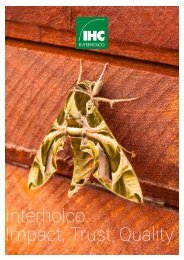Nomenclature Générale des Bois Tropicaux - 7ème édition
(english description below) Cette nomenclature est utilisée pour la mise à jour du 'Harmonized Code System' de l’Organisation Mondiale des Douanes. Dans la circulaire du 5 avril 2005, le Ministère de l’Economie, des Finances et de l’Industrie (France) reconnaît l’ATIBT comme « gardien du temple » de la nomenclature des bois tropicaux. La Commission Européenne mentionne la nomenclature de l’ATIBT comme document de référence pour la mise en œuvre du RBUE. Depuis 1954, l’ATIBT a établi et mis à jour une nomenclature des bois tropicaux faisant correspondre chaque espèce botanique avec un nom pilote reconnu internationalement. La détermination du nom pilote d’une essence est cruciale, car sa commercialisation dépend très largement de l’adoption de ce nom par le public. Le nom pilote assure la protection de l’appellation commerciale de l’essence et l’intégrité des propriétés qui lui sont attribuées, sans risque de confusion. The 1982 version of the general timber nomenclature has finally been updated as some of the 1,750 identified species, are no longer traded, while others, which were not previously included, are now on the market. The present revision has also integrated changes related to new taxonomy, in order to reflect the latest scientific developments. This Nomenclature has been used for the Harmonized Code System, updated by the World Customs Organization. The French Ministry of economy, finance and industry has given official recognition to ATIBT as the reference for the tropical timber nomenclature (NOR: PRMX0508285C of April 5th 2005). The European Commission refers to ATIBT nomenclature as a reference document for the implementation of the EUTR regulation. Since 1954, ATIBT has established and updated a nomenclature of tropical wood, linking each botanical species with an internationally recognized pilot name. A sigle wood species may have many common names; when trading across different countries, this may lead to confusion. Fixing the pilot name of a timber species is crucial, to protect the commercial denomination of the species and guarantee the veracity of the properties linked to that species, without confusion.
(english description below)
Cette nomenclature est utilisée pour la mise à jour du 'Harmonized Code System' de l’Organisation Mondiale des Douanes. Dans la circulaire du 5 avril 2005, le Ministère de l’Economie, des Finances et de l’Industrie (France) reconnaît l’ATIBT comme « gardien du temple » de la nomenclature des bois tropicaux. La Commission Européenne mentionne la nomenclature de l’ATIBT comme document de référence pour la mise en œuvre du RBUE.
Depuis 1954, l’ATIBT a établi et mis à jour une nomenclature des bois tropicaux faisant correspondre chaque espèce botanique avec un nom pilote reconnu internationalement. La détermination du nom pilote d’une essence est cruciale, car sa commercialisation dépend très largement de l’adoption de ce nom par le public. Le nom pilote assure la protection de l’appellation commerciale de l’essence et l’intégrité des propriétés qui lui sont attribuées, sans risque de confusion.
The 1982 version of the general timber nomenclature has finally been updated as some of the 1,750 identified species, are no longer traded, while others, which were not previously included, are now on the market. The present revision has also integrated changes related to new taxonomy, in order to reflect the latest scientific developments.
This Nomenclature has been used for the Harmonized Code System, updated by the World Customs Organization. The French Ministry of economy, finance and industry has given official recognition to ATIBT as the reference for the tropical timber nomenclature (NOR: PRMX0508285C of April 5th 2005). The European Commission refers to ATIBT nomenclature as a reference document for the implementation of the EUTR regulation.
Since 1954, ATIBT has established and updated a nomenclature of tropical wood, linking each botanical species with an internationally recognized pilot name. A sigle wood species may have many common names; when trading across different countries, this may lead to confusion. Fixing the pilot name of a timber species is crucial, to protect the commercial denomination of the species and guarantee the veracity of the properties linked to that species, without confusion.
You also want an ePaper? Increase the reach of your titles
YUMPU automatically turns print PDFs into web optimized ePapers that Google loves.
Liste des noms pilotes des bois tropicaux avec renvoi aux noms scientifiques /// 75
PILOT NAME BOTANICAL NAMES COMMON NAMES
Merpauh
Mersawa
Mertas
Messassa
Merkusii Pine
Metondo
Swintonia floribunda Griff.
Swintonia penangiana King
Swintonia pierrei Hance
Swintonia schwenkii Teijsm. & Binn.
Swintonia spicifera Hook. f.
Swintonia spp.
Anisoptera costata Korth.
(Syn. Anisoptera cochinchinensis)
Anisoptera curtisii Dyer
Anisoptera glabra Kurz
Anisoptera laevis Ridl.
Anisoptera marginata Korth.
Anisoptera scaphula Pierre
Anisoptera thurifera Blume
Anisoptera spp.
Ctenolophon parvifolius Oliv.
Brachystegia spiciformis Benth.
Brachystegia taxifolia Harms
Brachystegia utilis Burtt Davy & Hutch.
Brachystegia p.p.
Pinus merkusii Jungh. & de Vriese
Cordyla africana Lour.
Cordyla pinnata Milne-Redh.
Miama Calpocalyx heitzii Pellegr. Miama (GA)
Milo
Mirindiba doce
Thespesia populnea Soland.
Glycydendron amazonicum Ducke
Mjombo Brachystegia boehmii Taub. Mjombo (MZ)
Mlanje-Cedar
Moabi
Moambé jaune
Monghinza
Mopaani
Widdringtonia whytei Rendle
Baillonella toxisperma Pierre
(Syn. Mimusops djave)
Annickia chlorantha Setten & Maas
(Syn. Enantia chlorantha)
Manilkara mabokeensis Aubrev.
Manilkara obovata J.H. Hemsl.
Manilkara spp.
Colophospermum mopane J. Léonard
(Syn. Copaifera mopane)
Mopé Spondias mombin L.
Civit (PK) ; Civit Taung Thayet (MM) ; Merpau
(MY) ; Merpauh (MY) ; Muom (KH, VN) ; Taung-
Thayet (MM) ; Thayet-Kin (IN)
Kaunghmu (MM) ; Krabak (TH) ; Mai Bak (LA) ;
Mersawa (ID, MY, PG) ; Palosapis (PH) ; Pengiran
(MY) ; Phdiek (KH) ; Pik (TH) ; Ven-Ven (VN)
Adau (BN) ; Besi Besi (MY) ; Ctenolophon (PG) ;
Kalek Bung Cung (ID) ; Kayu Bawang (ID) ; Latak
manuk (ID) ; Litoh (MY) ; Mertas (ID) ; Sudiang
(PH)
Kaputu (CD) ; Messassa (MZ) ; Mupanga (AO) ; Mutupu
(CD) ; N’Tundu (TZ)
Kia (VN) ; May Pek (LA) ; Mindoro-Pine (PH) ;
Srâl (KH) ; Tapulau (PH) ; Tenasserim-Pine (MM) ;
Thong (VN) ; Tinyu (MM) ; Tusam (ID)
Dimb (SN) ; Metondo (MZ) ; Mgwata (TZ) ;
Mpachamu (TZ) ; Mroma (TZ)
Catalpa (GF) ; Clemón (CO, VE) ; Gros Mahaut
(HT) ; Mahot rivière (GF) ; Majaguilla (PR) ; Milo
(AS, TO) ; Miro (PF) ; Palo de jaqueta (PR) ; Paraspeepal
(IN) ; Toromiro (PF) ; Zavé (DO)
Mirindiba doce (BR) ; Pau de casca doce (BR) ; Wandékolé
(GF)
Mlanje-Cedar (ZA) ; Mlanje-Cypress (ZA) ; Nkungusa
(MW)
Adjap (CM, GQ) ; Adza (GA) ; African Pearwood
(GB) ; Ayap (CM, GQ) ; Dimpampi (CG) ; M’Foi
(GA) ; Moabi (AO, CD, CG) ; Muamba jaune (CD) ;
Oabé (GA) ; Oko Uku (NG)
Baoué (CI) ; Mfo (CM) ; M’Fol (GA) ; Mfoo (CM) ;
Moambé jaune (AO, CG) ; Osopupa (NG)
Adzacon-aboga (GA) ; Monghinza (CF) ; Sisina (CI)
Chanate (MZ) ; Mopaani (ZW) ; Mopane (ZM)
Jobo (VE) ; Mombin (GF, HT) ; Mopé (MX, VE) ;
Moppé (SR)














